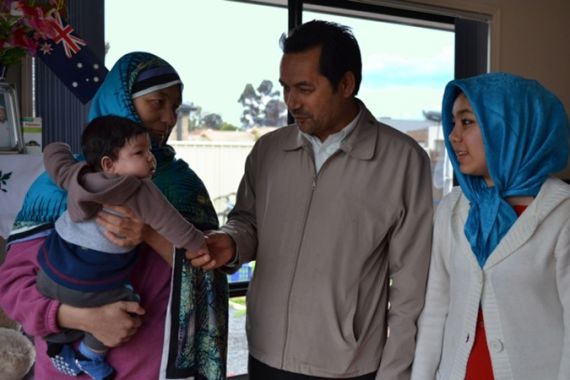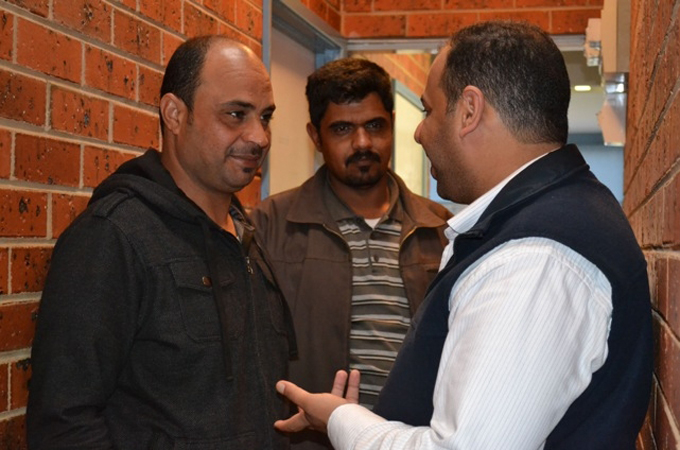Tales from a leaking boat
The Australian government will implement a new plan that would send asylum seekers to Malaysian facilities first.

 |
| Hamood and Ghanem say that they would not have tried to travel to Australia if they had to be held in Malaysia first [Photo: Soraya Lennie] |
Aziz crammed into the cargo hold of a tiny fishing boat as it left the Indonesian port. He and the 17 other men aboard had their sights on Australia. Only four days in, it happened – the engine exploded, blowing acrid smoke into the cabin, choking Aziz and the other terrified passengers. The boat was adrift in the middle of the Indian Ocean, in the middle of an illegal voyage to seek asylum in Australia.
“We sat like this,” Aziz says, hugging his knees to his chest. “We couldn’t move, we were just [huddled together] shoulder to shoulder.”
Finally, the Australian Navy spotted the small boat and three days later the men were at Australia’s immigration processing centre on Christmas Island, just 360km south of Jakarta.
“It was very dangerous, very risky, how can you imagine it? It’s so hard. You sacrifice your life, you could be a victim and every minute, it’s possible you’re going to drown in the sea,” he adds.
And many do drown. Some die in the middle of the ocean, often days before immigration officials in either Indonesia or Australia notice. The latest incident occurred in December 2010, when a boat smuggling refugees crashed off Christmas Island, resulting in the death of some 48 people. But perhaps the worst tragedy took place almost a decade earlier, in October 2001, when more than 350 people drowned after their boat sunk at sea. Most were from Afghanistan, Iraq and Iran. Many were children, trapped in the sinking hull. Like the Christmas Island disaster, it sparked a bitter political spat as both sides blamed each other’s policies for the tragedy.
The Australian government, headed by Prime Minister Julia Gillard, is under pressure to avoid these kinds of disasters. It’s also trying to avoid a public backlash against any government perceived as soft on so-called “queue jumpers”. In Australia, the issue makes and breaks politicians and wins and loses elections.
Playing politics
The former government of right-wing Prime Minister John Howard knew that best. August 26 will be the tenth anniversary of the “Tampa Affair”, in which the Howard government sparked a diplomatic row with Norway when it refused permission for the Norwegian freighter MV Tampa to enter Australian waters. Its crew had rescued more than 400 asylum seekers from a sinking fishing boat heading to Australia. Just two months later, Howard’s government famously – and wrongly – accused other asylum seekers of throwing their children overboard to secure Australian naval rescue and subsequent passage to Australia. Only one month later, Howard sailed to victory in the federal election on a platform of border security.
Between 1999 and 2001, Howard reintroduced Temporary Protection Visas and signed the “Pacific Solution”, a policy in which asylum seekers were transferred to the tiny Pacific island nation of Nauru for processing. That government’s treatment of refugees appalled the United Nations and human rights groups.
Despite the tough policy, the number of people arriving by boat increased sharply after the government introduced these measures. The numbers then plummeted and remained low until 2009. That year, more than 2,849 people arrived, compared to just 161 the previous year.
The opposition said that this spike was because Prime Minister Kevin Rudd scrapped many of Howard’s policies in favour of a more humane approach. Some refugee advocates said that the spike in unauthorised arrivals reflected changes in global conflicts. But as Gillard took over, under pressure after an embarrassing and damaging leadership spill, she put a temporary freeze on processing the claims of Sri Lankan and Afghan refugees, pending a review. At the time, she said that the reality that confronted Howard’s government confronted her own as well.
On Friday, Australia formally struck a deal with Papua New Guinea under which asylum seekers detected in Australian waters can be sent to PNG’s Manus Island. It too was part of Howard’s Pacific solution. The deal follows the Gillard government’s arrangement with Malaysia. Dubbed the “Malaysian Solution”, her government will send 800 asylum seekers to Malaysian transit centres while the immigration department processes the claims.
In return, Malaysia will send 4,000 genuine refugees to Australia. The Gillard government says that the arrangement “demonstrates the resolve of Australia and Malaysia to break the people smugglers’ business model, stop them profiting from human misery, and stop people risking their lives at sea”.
But Amnesty International is critical. “Although the Australian Government is very close to sending people there (to Malaysia), there are a lot of details to be decided, like who’s going to look after unaccompanied minors? It’s very worrying,” says Dr Graham Thom, Amnesty International’s Refugee Coordinator.
Thom says that the proposed scenario is far from ideal. The refugees will be housed in a temporary facility set up by the Australian government. It is significantly different from Malaysia’s own detention centres, which Dr Thom describes as horrible and appalling. After a period of up to 45 days, they will be permitted to enter the community to live while their applications are processed.
But Amnesty International is concerned that Malaysian authorities will still arrest the refugees and send them to their own detention centres, where Amnesty says disease, assault and mistreatment are rife. Moreover, Thom says that the proposed people swap undermines Australia’s standing at the UN and in the international community.
“We are a convention country, we put up our hand to protect people. So for us to be removing people to a non-convention country is a very serious breach of our international obligations. Secondly, it’s even more worrying that country is Malaysia, which has a very poor record,” says Thom.
But the deal is stuck in its tracks. At the eleventh hour, the High Court granted a two-week injunction against sending anyone to Malaysia on the grounds that it may not be legal. It began hearing the case on August 22. Lawyer David Manne, Executive Director of the Melbourne-based Refugee and Immigration Legal Centre, filed the injunction. He is representing the first 42 asylum seekers awaiting deportation to Malaysia under the people swap. Among them are six children. Mr Manne argues that Immigration Minister Chris Bowen is the legal guardian of the underage asylum seekers and is therefore legally bound to protect them. He is also arguing that the situation in Malaysia is not satisfactory.
Bowen told Fairfax Media as he announced the arrangement, “I expect protests, I expect legal challenges, I expect resistance.” He has received all three. But Bowen contends that the government is well within its rights to send people to a third country and that the government has followed the law to the letter.
Will the ‘Malaysian Solution’ work?
The new proposal has disappointed refugees who have now settled in Australia. Many of them arrived undocumented by boat and, after having their applications for asylum approved, consider themselves lucky to be permanent residents, if not citizens. Hamood is one of them. He says he would not have travelled unauthorised to Australia if the Malaysia deal were in place as he fled Kuwait. No, he shakes his head resolutely, “I would have gone to a country that I knew would accept me.”
His friend, Ghanem, fled instability in Iraq at the same time. He sold his car, begged and borrowed in order to pay a smuggler to get him and his younger brother to safety. After ten hellish, sleepless days at sea, aboard a leaking boat with a smoking engine, they made it. They spent nine months in detention, but are now trying to settle into a new life. He agrees with Hamood – if the Malaysia deal were on the table then, he would never have risked it.
“At the time, we were travelling as refugees. It was not a matter of choice. When we arrived in Malaysia we were told you can go to Australia. We didn’t have the opportunity to check up on the country, or the politics, or the living standards. Of course now if you know the government is not accepting refugees, what are you doing to do? Of course people will stop coming, or at least the numbers will reduce.” And that’s the goal of Gillard’s Malaysia deal.
Nasim Gulzari was a shopkeeper in Afghanistan when the Taliban took over his village. He fled in 1999. Through a people smuggler and a fake Pakistani passport, he made it onto a boat and eventually into Australia. It cost him eight thousand dollars for a chance at a new life.
Although he may have arrived illegally (at least according to the Australian governments interpretation of International Law), Gulzari says that the government has the responsibility to protect its borders. He, too, strongly believes the Malaysia deal will work: “The boats will stop certainly, in a couple of months they’ll see the results.” But like many others, he doesn’t think that the Malaysia deal is the most humane approach. “People have to flee. In my opinion, these asylum seekers deserve to be treated properly.”
Gulzari, his wife Wazir, and their five children have settled in the Goulburn Valley, in Northern Victoria, and proudly display an Australian flag among family photographs in their lounge room. What they have is what those crossing the sea want.
Others, however, doubt that the “Malaysian Solution” will have the intended effects. Aziz, from Afghanistan, believes that the chance at a better life is worth the risk of Malaysian detention. Will the Malaysian deal work? “Honestly? No, never. Why? Because people are living in very bad situations in their home country. When they reach Christmas Island, the government assesses their health, gives them food, they’re safe at least. In Malaysia, no matter how bad it is there, they’d prefer it. Because eventually, they’ll be processed. They’ll never stop the boats.”
He admits that he and Gulzari are queue jumpers, but asks those who have never been in his position, “If your house is on fire, it’s not a choice to wait behind people queuing to get out the doors. You’d jump out the window to save your life. Wouldn’t you?”